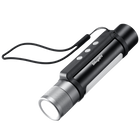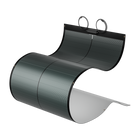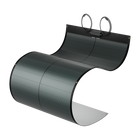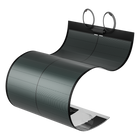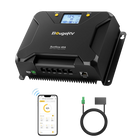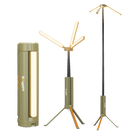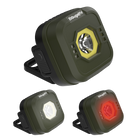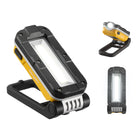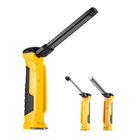What is a Teardrop Camper?

Since the first teardrop camper was introduced in the 90s, it never got out of the spotlight till now. Teardrop campers are great for people who love camping and traveling and don't want to miss out on their comfort. Besides comfort, a teardrop camper is easy to tow and environment-friendly as you don't need extra fuel to move it around. You can carry almost all the essential appliances; still, two or more people can sleep in it hustle-free. Now that you are all set to go on a tour, don't forget to arrange a power source for your teardrop camper.
Going on a trip without a proper power source means not being able to run any appliance and compromising your comfort. Typically people take a generator or inverter with them, but these aren't ideal if you need a consistent and high-watt enduring device. That's where a solar panel helps you. A solar panel efficiently allows you to run high to low-watt equipment without a power hookup. Solar panels have everything when you want to run an air conditioner or need an electrical heater for extra warmth.
Explore more about teardrop campers and how solar panels are a great choice. Let's delve into it!
Parts of a Simple Teardrop Camper
CIGS Solar Panel to Power Your Teardrop Camper
Our Top CIGS Solar Panel Picks
What is a Teardrop Camper?
A Teardrop Camper refers to a small trailer that can easily be towed by a vehicle, doesn't matter small or large. It is named "teardrop" because its shape is tapered on one end and round on the other. On average, a Teardrop Camper is six feet wide with a height of 10 feet and has a small sleeping cabin and galleys used for cooking, cleaning, and other activities.
If you’re tight on budget and get a small teardrop trailer, you will not be able to stand in it, and it will be without a bathroom. But it can serve a basic purpose. However, if you have enough budget, buying a large trailer can make things easy as it can accommodate two or more people, has a bathroom, and allows you to stand.
Types of a Teardrop Camper
There are two types of teardrop camper: a classic/small teardrop camper and a large teardrop camper. You won't find much external difference except for size and the facilities inside.
Small or Classic Teardrop Camper
This typical and economical one features a small galley, cabin, and trailer. It can accommodate only two people and doesn't give you room to stand up. Storage space is minimal, and you can only bring a tiny fridge, a little cooking setup, and other small appliances. A small car can easily tow it around, so you don't have to arrange any big vehicle.
Large Travel Teardrop Camper
A large camper can easily accommodate around four people and provide proper space to stand up and walk around. You will also get a bathroom, shower, and considerable space to store all your appliances. In this, bringing large appliances like refrigerator, stove, etc., isn't a difficult task.
Parts of a Simple Teardrop Camper
The teardrop camper usually comprises three parts: Galley, Cabin, and Trailer. All these parts combine to give you a perfect feeling of home. Here's the detail of each part and how you can utilize it effectively:
Cabin
The cabin is also a sleeping and relaxing area and has enough room for two people to sleep. In this, you can easily fit a queen-sized mattress, pillows, comforters, etc. It also features a door and ventilation window on the roof to promote airflow. However, if you want to make it comfier, you can design it accordingly and bring a more natural look.
Gallery
The gallery is where you place your appliances and do all the other work, including cooking, cleaning, etc. Small teardrop trailers can only fit small and lighter appliances; however, if you have a large one, you can bring other appliances like a stovetop, refrigerator, etc.
Trailer
The trailer is the load bearer of the galley and cabin, and you hook it with your car to move the camper around. There's also a container-like space where you can place everything, like a generator or a folded solar panel.
CIGS Solar Panel to Power Your Teardrop Camper
Now that you've got to know all the nitty-gritty of a Teardrop Camper, it's time to find something to give it the necessary power. A CIGS (Copper, Indium, Gallium, Selenide) solar panel is the handiest equipment in this case because it helps your appliances to run smoothly and is eco-friendly.
You don't have to give it fuel as it'll produce electricity by taking energy from the sun. When the light falls on its first layer, it gets absorbed and trapped inside, resulting in quick power generation. Moreover, CIGS solar panels don't use cadmium's harmful element, which is the reason behind its swift popularity.
Why is CIGS Better than a Mono-Crystalline Solar Panel on a Teardrop Camper?
If you are confused about whether you should go for a CIGS solar panel or a mono-crystalline one is what you need, we have made it easy for you. Here's the difference between both, so you can understand why CIGS is better with a Teardrop Camper:
- A CIGS solar panel is better than a crystalline one because the former is more light-sensitive. Even a CIGS 100W flexible solar panel generates similar heat to a typical monocrystalline solar panel. This means you can quickly run all your heavy appliances like air conditioners or refrigerators on tour without worrying about power drop.
- Secondly, CIGS uses significantly less energy to produce power than crystalline ones. So, even if you place your trailer in an area where the sun isn't fully blazing, your solar panel will still generate enough heat.
- As a CIGS solar panel is made of powder elements, it is flexible and resistant to cracks compared to a monocrystalline solar panel that features a crack-sensitive silica film.
- Fitting CIGS on your teardrop camper is beneficial as a moving vehicle's functionality doesn't get affected. In contrast, a monocrystalline solar panel gets damaged and worn out while moving, spoiling your whole tour.
- Lastly, CIGS solar panels weigh only 2 to 3 kg/m2, which is way less than monocrystalline ones with around 5 kg/m2 weight. You can easily store CIGs in the trailer's container with other appliances.
Our Top CIGS Solar Panel Picks
Here are our top CIGS solar panel choices for your next teardrop camper tour:
200W CIGS Thin-Film Solar Panel
If you want some aesthetically pleasing and highly efficient CIGS solar panel, you can't go wrong with our 200W CIGS Thin-Film Solar Panel. The solar cells of this panel have 16% efficiency with a temperature limit of -40°F to +185°F. Overall, the panel has a significant absorptive coefficient and thinner structure, resulting in enhanced flexibility.
It has a 200 W power output and a pre-applied adhesive that makes it easier for you to install. Roll it and put it aside when not in use. You can use it on all uneven surfaces like boats, ships, teardrop campers, etc.
100W CIGS Flexible Solar Panel
Anyone who's tight on budget and wants something classy at a low price should buy this fantastic 100W CIGS Flexible Solar Panel from BougeRV. It has a 360° rotation flexibility and gets fixed everywhere within minutes.
The solar cells efficiency and temperature limitations of this panel are the same as of the 200 W one, while the maximum power output is 100 W. It works great under light conditions or in shady areas, making it a perfect product!
Conclusion
Teardrop Campers are great for everyone who wants comfort while living far away from home. Moreover, this comfort doubles when you take a CIGS solar panel and other appliances for a strong power backup. If you are looking for the best CIGS solar options, BougeRV has everything.
Our solar panels are highly flexible and offer maximum power output, allowing your appliances to run smoothly. So, don't wait; grab your favorite CIGS solar panel now!








